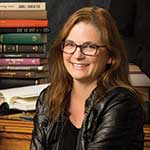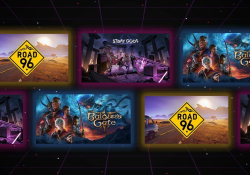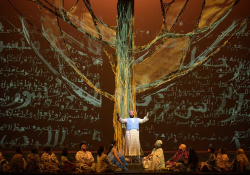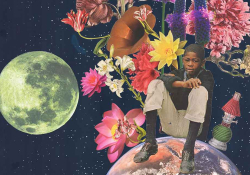An Artistic Window into Food Justice: A Conversation with Smithsonian Curator Samir Meghelli
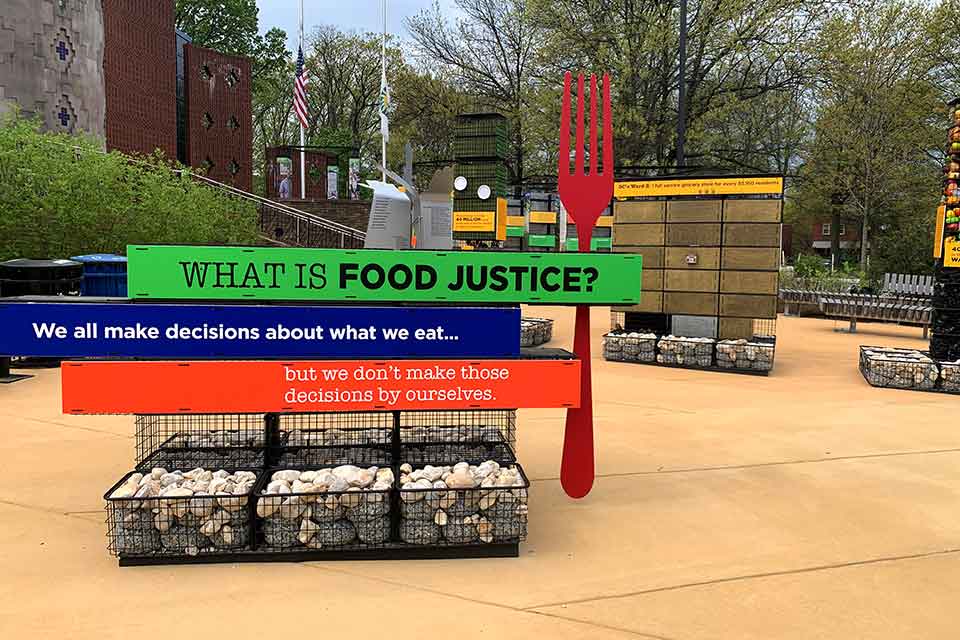
The Smithsonian’s Anacostia Community Museum exhibition Food for the People: Eating and Activism in Greater Washington is an indoor-and-outdoor exhibit taking a deep dive into food-and-justice issues in the Washington, DC, area. Here, WLT’s culture editor interviews curator Samir Meghelli about the exhibition and where to begin in addressing issues of food inequality.
Michelle Johnson: How did you go about planning this exhibit? Where did the original idea come from, and how did you set about executing it?
Samir Meghelli: Our museum is situated in Washington, DC’s, Ward 8, east of the Anacostia River—which has historically been a kind of social and economic barrier from the whiter, wealthier, more central parts of the city—and is in a so-called “food desert” (we join many scholars and organizers in favoring the term “food apartheid”). Despite a rich history of gardening, farming, and fresh food access, DC’s Ward 8 today has only one full-service grocery store to serve more than 85,000 residents, as compared to other wards in DC where there are up to as many as sixteen grocery stores. Food insecurity—or hunger or the imminent threat of it—is a widespread reality, with DC having one of the highest child hunger rates in the nation.
We wanted to historicize and contextualize these issues by asking and trying to answer: Where does our food come from, whose labor makes our food possible (and under what conditions is that labor performed), why do some communities have easy access to fresh food and others not, and what are the environmental and public health impacts of the food we consume? Over the course of more than two years, we did traditional archival research in collections across the region, did community collecting of artifacts and documents, and also conducted oral history interviews with a wide range of community members: longtime residents, organizers and activists, farmers, food workers, government officials, nonprofit leaders, restaurant owners, and others. We did that to help document the history, and those interviews will become a permanent part of our museum’s archives, but they have also deeply shaped how we narrate the stories in the exhibition—that is, as much as is possible from the perspective of those who lived, have made, and are still making this history.
Johnson: On the Smithsonian website, the first sentence describing this exhibit says, “With every bite of food we eat, we have an opportunity to help remake an unjust and unequal food system.” How does this exhibit illustrate that statement?
Meghelli: We want to illuminate how our small, everyday decisions around food (what we eat, where we get our food) are constrained by a fundamentally unjust food system and also that our decisions have consequences. We illustrate this in a number of ways, but one example is in the introductory section of the exhibition: we follow an iconic DC food—the chicken wing—through the food system, including production and processing (on the Eastern Shore of Maryland, Virginia, and Delaware) where there are large concentrations of poultry-raising and processing, distribution to food wholesalers, grocers, and restaurants, to preparation by restaurant staff, consumption by everyday residents, and disposal of what remains into landfills and “waste-to-energy” facilities. At each step, we reveal the labor conditions of those working to make the chicken wing possible (from farm to table), the environmental consequences of its production and disposal after consumption, and much more. It’s a window onto how everyone’s choices around food—especially those with the resources to make decisions about where they’re purchasing their food from—are meaningful.
We want to illuminate how our small, everyday decisions around food (what we eat, where we get our food) are constrained by a fundamentally unjust food system and also that our decisions have consequences.
Johnson: This exhibit specifically addresses food inequality issues in the DC area, but I suspect some of the issues are those that affect people worldwide. When people visit your museum and then return to their homes elsewhere, what do you hope they take with them?
Meghelli: The unjust shape of our food system is not predetermined. It has its origins in human choices—at the government, corporate, and consumer levels—that continue to shape it. We hope people leave better informed about how those various forces have worked to perpetuate inequality in our local and global food systems, but also that they feel inspired and empowered to get involved in their local communities. Throughout the outdoor and indoor parts of the exhibition we offer a myriad of suggestions for how people can make an impact in their own communities. And in the concluding section—called “Ingredients for Food Justice”—visitors can watch clips from interviews we did with people working on the front lines to transform our food system into a more just and sustainable one, in which they offer meaningful action steps for everyday people.
Johnson: Why has the capital of one of the wealthiest countries in the world so struggled with food insecurity?
Meghelli: There are many—and complex—reasons why DC has struggled with food insecurity. But most of these reasons are common to communities where food insecurity is a reality: poverty, chronic economic underdevelopment, a history of racist and discriminatory public policy, etc. One additional historical (and present-day) factor that has indelibly shaped the social and and economic conditions in DC is the lack of political self-determination.
Johnson: What are a few of the stories you tell in this exhibit?
Meghelli: We’ve foregrounded stories of communities organizing for food justice, particularly from the 1960s to the present. We highlight the visionary Free Breakfast for Children Program of the Black Panther Party, which had a presence in DC and sought to meet the community’s needs at a time when there was not yet an expansive federal breakfast program. We also feature the story of Beatrice Gray, who led a response in the 1960s to the price-gouging and poorly maintained supermarkets in her southeast DC neighborhood and the broader city: she organized buying clubs whose members joined together to buy bulk food from wholesalers at cheaper prices. In 1970 she converted the buying clubs into a brick-and-mortar store, the Martin Luther King Jr. Co-op, which opened in the basement of the Arthur Capper public housing projects, becoming the first cooperative grocery store in the nation to open inside of a public housing community.
In the 1980s the Community for Creative Non-Violence (CCNV) operated free health clinics, ran soup kitchens, and served as an activism hub for people experiencing homelessness in DC. Mitch Snyder, Carol Fennelly, and fellow CCNV members staged an elaborate banquet for members of Congress—with a menu featuring crab quiche, boysenberry shortcake, and bacon-wrapped green beans, made entirely from food recovered from dumpsters outside local supermarkets—to bring national attention to the issue of food waste. In 1982 Congress passed a resolution encouraging grocery stores and wholesalers to distribute edible food that would otherwise be discarded. Soon after, local supermarkets began donating unsold food to the newly forming food banks of the era, sparking a movement that has grown exponentially in the years since.
We also feature a lot of contemporary stories, like that of the Grocery Walk of 2017, which brought together hundreds of people to march two miles from the only full-service grocery store in DC’s Ward 8 to the community’s historic downtown to highlight the lack of fresh food options and to push for greater investment in food access programs. These are just a few of the stories we share in the exhibition.

We’ve foregrounded stories of communities organizing for food justice, particularly from the 1960s to the present.
Johnson: For most of us, who’ve thought much less about food justice than you have, where do we start? Is the entry-point question, Where did this food come from?
Meghelli: Yes, by asking seemingly simple questions about our food—where did it come from, whose labor made it possible (and in what working conditions), what are its environmental and public health impacts, why do some communities have easier access to fresh food than others—we can begin to pull back the curtain on the too-often invisible processes of our food system. And in seeking to answer those questions, we can better understand the challenges we collectively face in trying to transform our food system into a more just and sustainable one.
Johnson: You’re a former DJ who has been interviewed about music and written liner notes, so I’m going to ask: What are some songs that would be on a playlist for this exhibit?
Meghelli: To represent our museum’s neighborhood of Anacostia and DC’s homegrown music genre of Go-Go: the Junkyard Band’s “The Word” (1986), which directly addresses the impacts of the drastic cuts made to social welfare programs—like food stamps—in the 1980s.
One section of our exhibition is called “A Taste of Home: Preserving Local Food Cultures,” so a fitting track would “Mambo Sauce,” by southeast DC’s own Christylez Bacon, which pays tribute to the iconic local condiment.
Another section—entitled “Food as a Human Right?”—explores how, at various moments over the course of the twentieth century, the federal government, local communities, and nonprofits and organizers have differently addressed food insecurity and hunger. A range of songs that tackle those subjects (from a local to a global scale) include:
- Talib Kweli’s “Eat to Live”
- Bob Marley & The Wailers’ “Them Belly Full (But We Hungry)”
- Sade’s “Pearls”
- Youssou Ndour’s “Food for All”
Another section of the exhibition is called “The People Behind the Plate (From Farm to Table),” which looks at the labor that makes our food possible. We begin by exploring how foundational slavery and post-emancipation labor were to the American economy (including food economy), so a traditional African American “work song” known as “Hoe Emma Hoe” would be a worthwhile inclusion on the playlist.
In that same section of the exhibition, we delve into the history of the United Farmworkers’ movement. El Teatro Campesino’s “El Picket Sign,” a huelga (or “strike”) song, was written as part of that movement’s efforts to raise awareness about—and push for improved—farmworkers’ rights in the 1960s and ’70s.
And to end on a somewhat lighter and more whimsical note with songs that make reference to healthy eating: Tierra Whack’s “Fruit Salad” and A Tribe Called Quest’s “Ham ’n’ Eggs.”
The outdoor exhibition also features a sculptural tribute to our nation’s essential food workers.
Johnson: The pandemic delayed the opening of the indoor portion of the exhibit and, I suspect, has also decreased the number of visitors overall, but with the exhibit open for another year, there is still time for people to visit. From those who have already visited, what has been the response? How are people interacting and reacting?
Meghelli: The response has been really positive so far. When the outdoor portion of the exhibition opened in the spring, we were the first of the Smithsonian museums to open a new on-site exhibition since the pandemic’s onset more than twelve months prior. So already there was excitement around that. And then, people were drawn by the fact that the exhibition tackles such urgent and local issues—food insecurity, hunger, lack of fresh food access—at a time when these issues have only been exacerbated. There are large-scale photos of a wide range of people in the DC region who are working to transform the food system, along with their personal stories and ideas for how we can each contribute to such efforts. The outdoor exhibition also features a sculptural tribute to our nation’s essential food workers, where visitors are able to leave notes of gratitude or share stories about their own food worker experiences, and they’ve been sharing some truly moving messages.
The exhibition tackles such urgent and local issues—food insecurity, hunger, lack of fresh food access—at a time when these issues have only been exacerbated.
The indoor exhibition offers an opportunity for visitors to dive even deeper into these issues with actual artifacts, video interviews, and hands-on interactives. People have expressed the fact that they’ve been both heartened by the attention being shown to food justice and inspired to want to get more involved. And that has been our genuine hope all along.
Johnson: For people who want to thoughtfully engage with this issue, whether they’re able to get to the exhibit or not, what are a few resources—books, podcasts, documentaries, etc.—that you recommend?
Meghelli: There are an incredible number of resources available now, especially as awareness and interest has grown so much in recent years. No single resource will provide a full view of the issue, but here are a few that come to mind:
In conjunction with the recent debut of our exhibition, we hosted a panel discussion entitled “Food Justice in the Nation’s Capital,” which is available for viewing.
Books
Freedom Farmers: Agricultural Resistance and the Black Freedom Movement, by Monica M. White
Black Food Matters: Racial Justice in the Wake of Food Justice, edited by Hanna Garth and Ashanté M. Reese
Big Hunger, by Andrew Fisher
Food Politics, by Marion Nestle
The Omnivore’s Dilemma, by Michael Pollan
The Food Fighters: DC Central Kitchen’s First Twenty-Five Years on the Front Lines of Hunger and Poverty, by Alexander Justice Moore
Documentaries
Food Chains (2014)
A Place at the Table (2012)
Follow the Food (2019–21)
Wasted! The Story of Food Waste (2017)
Food, Inc. (2008)
Podcasts
The Just Food Podcast
Edible Activist
The Food Chain
The Leading Voices in Food
September 2021
Editorial note: WLT’s July 2022 issue will include a cover feature devoted to the theme of food and justice from a literary perspective.
 Samir Meghelli is a historian, writer, and educator who serves as senior curator at the Smithsonian Institution’s Anacostia Community Museum in Washington, DC. Dr. Meghelli is co-author of The Global Cipha: Hip Hop Culture and Consciousness (2006, with James G. Spady and H. Samy Alim) and co-editor of New Perspectives on the History of Marcus Garvey, the U.N.I.A., and the African Diaspora (2011). He is the curator of the Smithsonian Anacostia Community Museum’s newly opened exhibition, Food for the People: Eating and Activism in Greater Washington (2021–22), and the recent A Right to the City (2018–22), from which a digital exhibit has been made available online.
Samir Meghelli is a historian, writer, and educator who serves as senior curator at the Smithsonian Institution’s Anacostia Community Museum in Washington, DC. Dr. Meghelli is co-author of The Global Cipha: Hip Hop Culture and Consciousness (2006, with James G. Spady and H. Samy Alim) and co-editor of New Perspectives on the History of Marcus Garvey, the U.N.I.A., and the African Diaspora (2011). He is the curator of the Smithsonian Anacostia Community Museum’s newly opened exhibition, Food for the People: Eating and Activism in Greater Washington (2021–22), and the recent A Right to the City (2018–22), from which a digital exhibit has been made available online.
